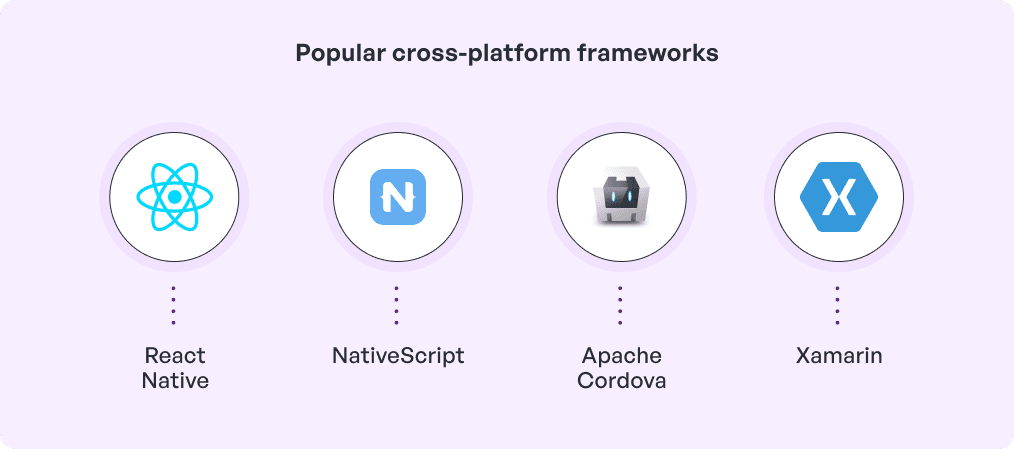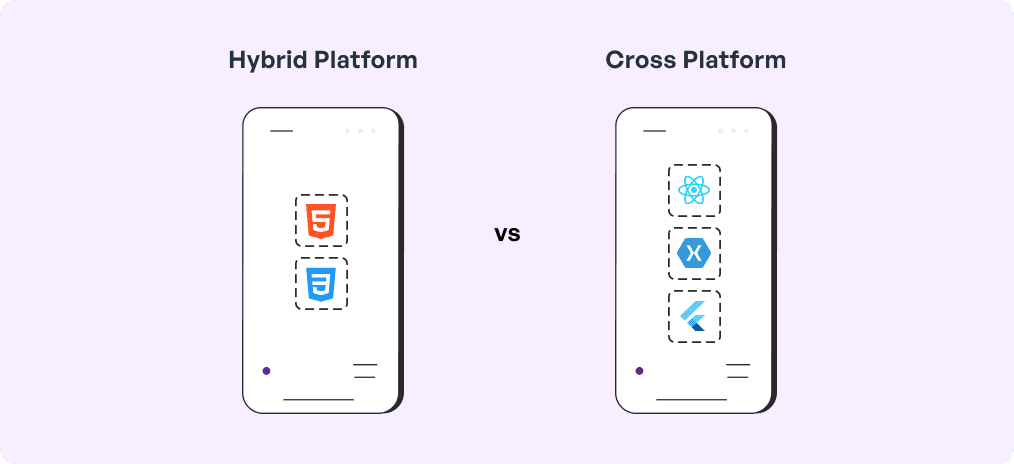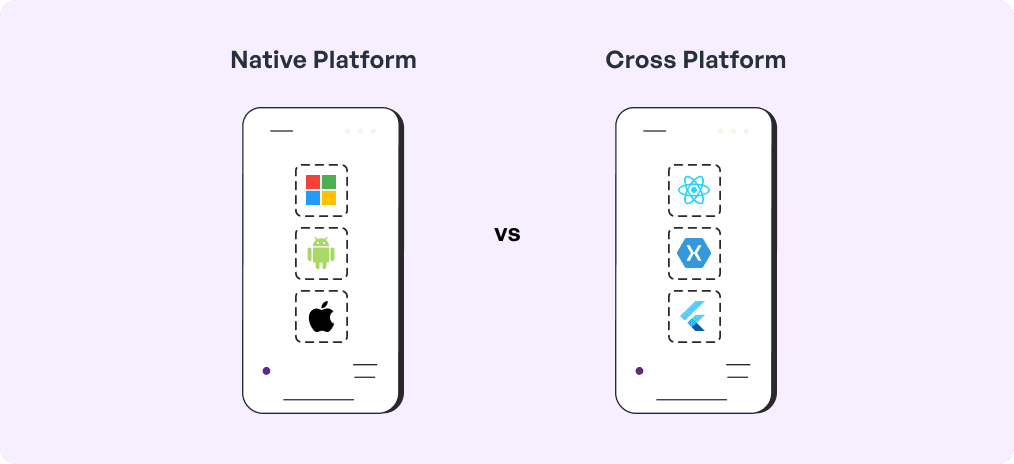The mobile app economy is growing like never before driven by rapid smartphone adoption and demands for flawless on-the-go experiences. No wonder, the app industry today is valued at half a trillion dollars with 5.1 trillion in app hours. However, while building apps for businesses has become a mandate, it is never a cakewalk and requires ample time and resources. This is when you might want to consider an app that reaches both iOS and Android users without increasing workload or spending extra yet ensuring consistency across devices.
Well, cross platform app development does exactly that which saves time, money, and resources. It is more like casting a wide net but with one smart throw! Its tools are constantly advancing, for example functioning on more than one architecture, which further makes this process a viable option. Altogether, this translates into businesses being able to capture the market quickly without having to spend a fortune. Subsequently, this keeps them ahead in the tech race while leaving competitors behind. Given this incredible advantage, as many as 50% of developers prefer this method to make the best of a unified codebase for creating apps thus reducing the project timeline and expenses for clients.
 Now, how is the process so efficient? Well, this is technically made possible with the help of cross platform frameworks. This article gives you an overview of the pros and cons so businesses can find the best suited ones for their app development. Read on to find out.
Now, how is the process so efficient? Well, this is technically made possible with the help of cross platform frameworks. This article gives you an overview of the pros and cons so businesses can find the best suited ones for their app development. Read on to find out.
Table of contents
Growing importance of cross platform frameworks
The advantages of cross platform development is being recognized since businesses worldwide are on the lookout for reaching a larger audience without doubling their effort. This is because they are mostly faced with the challenge to quickly and cost-effectively reach users on multiple devices and this can be accomplished through cross-platform development.
It is because this development method helps developers create a codebase that runs on both Android and iOS and often even on desktop and web which encourages businesses to move their apps to cross platform. The most popular frameworks for this are Flutter, React Native, NativeScript, Apache Cordova, and Xamarin to name a few. Each of them come with unique advantages, for instance native-like performances and API device access, minimizing redundant work.
As the digital market becomes more saturated, these cross-platform frameworks give a strategic edge that makes it easier for businesses to communicate the same message across the different platforms.
What is the cost of cross platform app development?
The cost to develop a cross platform app typically ranges between $10,000 to $60,000 depending on several factors like features, complexity, duration, and the expertise and experience of the developers. In fact, cross platform is one of the best ways to reduce app development costs which is helpful if the budget is low. Now that you have a fair idea of the expenses, let us look at the best cross platform frameworks along with their pros and cons to be able to make the most of your investment.
Pros and cons of cross platform frameworks
While cross platform frameworks offer the flexibility of multi-platform apps, there are trade-offs in terms of performance of each one. Weighing them with their advantages is necessary to be able to select the best one. Have a look:
Pros of React Native framework
- Cross-platform development: React Native is a popular mobile app development framework that allows for single code writing for an iOS or Android application which makes it cost and time-effective.
- JavaScript-based: The approach uses JavaScript which is one of the most popular programming languages and as a result, it has a large developer base that includes those from a web development background.
- Strong community and support: React Native, being backed by Meta (formerly Facebook) and a large community, has ample documentation, libraries, and resources.
- Hot reloading: This feature is a game changer and it speeds up the development process by demonstrating changes instantly without the app needing a full reload.
- Native-Like performance: In the case of many applications, React Native is able to produce a near-native experience, as it can mix UI components with platform-specific code when necessary.
Cons of React Native framework
- Performance limitations: The performance of high-end applications, for example those which have complex animations or perform heavy processing, might be better when native development is used.
- Dependency on native modules: React Native may bring in more native modules first for advanced features, which will then add to the development complexity and reduction in cross-platform uniformity.
- Limited customization for complex UIs: Custom, platform-specific UIs may be more complicated, in this case, it will be React Native’s components which may not completely adhere to all native platform nuances.
- Lags in support for new OS features: React Native is the one that sometimes lags behind in supporting the latest features on iOs and Android.
Pros of Kotlin framework
- Seamless android integration: Kotlin is a fantastic programming language that can be used for cross platform development via Kotlin Multi Platform and is officially supported by Google.
- Concise syntax: One of the advantages of using Kotlin over Java is that it has a more compact syntax which results in less boilerplate code and more readable program lines.
- Interoperability with Java: A true paradigm of Kotlin is that it is able to use Java programs and applications and libraries without any issues, besides that Kotlin is compact.
- Null safety: One of the important advantages of Kotlin is the null-safety features it offers. It helps developers avoid common null pointer errors and thus make the application more stable.
- Coroutines support: Such network calls require managing tasks like that Kotlin does with coroutines support already built-in, and hence it becomes so easy to implement asynchronous programming.
Cons of Kotlin framework
- Learning curve: Java developers who used Java before may find it difficult at first due to the non-identical syntax of Kotlin.Limited resources: Kotlin is on the rise very quickly only, which means it already has a bigger community and more resources of libraries with documentation etc)
- Limited resources: Kotlin is gaining popularity quickly, but still, its community and resources (libraries, documentation) are smaller than those of Java.
- Compilation speed: In terms of performance, the advantages of cross platform frameworks like Kotlin can produce longer building times than its counterpart Java for the sake of clean builds.
- Evolving language: Since Kotlin is still a fairly new language, it has often been updated during its young life, which makes it difficult sometimes to work with it in existing projects which were built using older versions.
Pros of Ionic framework
- Efficiency with cross-platform development: You can build an app that runs on all platforms (iOS, Android, and the web) using only one codebase, saving you precious time and money.
- User-friendly UI components: The tool is actually endowed with the whole range of materials that are pre-made and strictly follow the design guidelines of the operating system, thus, they are improving the UX.
- Support from an active community: An extensive and vibrant community makes available to the users a variety of documentation, plugins, resources for troubleshooting, and learning.
Cons of Ionic framework
- Performance limitations: The solution could encounter performance issues while dealing with complicated tasks, notably when compared with natural applications.
- Dependency with Cordova/Capacitor: This is the technology through which products acquire the ability to work with the hardwiring of the native devices, which can create other issues and may result in conflicting compatibility.
- Native functionality is very limited: The attainment of some native features may require the use of extra plugins or workarounds which would add complexity to the development process.
Pros of Flutter framework
- Single codebase: Write once and deploy on different platforms – Android, iOS, web, and desktop thus, achieving efficiency in time and resources.
- High-performance UI: Skia graphics engine is one of the features responsible for animation and rendering excellence
- Hot reload feature: Instantly seeing the changes that you made without restarting the program, which boosts the development and testing process.
- Rich widget library: Large pre-built widgets make it easy for the UI to look interesting and appealing to the end-user.
- Strong community and support: It is supported by Google with the help of frequent updates and the strong community that stands behind it.
Cons of Flutter Framework
- Large app size: One of the reasons for such high file size is that Flutter apps are in a different file size category due to which users may actually hesitate to download them. Hence, download rates are affected.
- Limited native features: Some platform-specific functionalities may need a custom native code or plugins which if included will increase the size of the app
- Dart language learning curve: Learning Dart is a prerequisite for working with the framework but it is less popular than Java and Swift.
- Limited third-party libraries: The number of third-party extensions is smaller than that of other frameworks such as React Native.
Pros of NativeScript framework
- Real Native performance: NativeScript, by reaching out directly to native APIs, is a robust platform that enables apps to achieve the responsiveness and performance characteristic of fully native applications.
- Write once, run everything: Writing only once and then running the app on both iOS and Android helps in saving the development time and effort while at the same time ensuring a consistent user experience.
- Abundant UI components: Rendering a large number of visually beautiful UI components for various user interfaces that belong to the platform and look and feel natively.
- JavaScript and TypeScript integration: NativeScript puts stress on languages like JavaScript and TypeScript, which is a plus point due to the fact that they suit best the web developers who move on to mobile app development.
Cons of NativeScript framework
- Larger app size: Certain libraries and dependencies potentially could result in larger download times. Such a situation also limits the availability of alternative libraries and resources. It should be noted that its smaller community of developers is somewhat less important, relatively speaking, if compared to the established frameworks of React Native and Flutter.
- Limited community and resources: Despite having few third-party libraries and resources, the limited size of its community is a lesser disadvantage in the context of more established frameworks like React Native or Flutter.
- Steeper learning curve: Those with a traditional web background find the process of taking a step towards a more mobile-oriented architecture a bit more difficult.
- Debugging complexity: Debugging could be trickier because of the native code interactions, thus, extending the time needed for troubleshooting.
If you are looking for cross platform app development, consider partnering with industry-leading mobile app development company like Simublade. Our expert developers specialize in creating apps for multiple platforms from a codebase which saves plenty of time and money. Product development for startups and enterprises become smooth with minimal investment yet robust functionality like native apps. We harness cutting-edge technologies to keep innovation in the forefront of every project they pick.
Hybrid vs cross-platform app development
There are several approaches to enabling the functionality of devices using only one codebase, and that is done in both hybrid and cross-platform app development. However, they have significant differences in implementation and abilities.
 Hybrid applications use web technologies such as HTML, CSS, and JavaScript and operate within a WebView in cell phones. They are the easiest to develop according to time, but their graphics are usually not so good and they do not give the users a native feel.
Hybrid applications use web technologies such as HTML, CSS, and JavaScript and operate within a WebView in cell phones. They are the easiest to develop according to time, but their graphics are usually not so good and they do not give the users a native feel.
In contrast, cross-platform frameworks such as Flutter and React Native became cooler with really good legitimate-to-native versions. As a result, hybrid apps, which do not provide any native functionalities even with the use of powerful web technologies, especially for graphic-enhanced apps, may have performance limitations.
Cross-platform applications may not be able to replace user iOS and Android experiences globally, but they may require more natively developed parts or additional plugins in order to get to the level of device integrations. Hybrid build is generally the default option for the simpler applications because it is less costly. But cross-platform development is adopted most times for the reason of achieving good performance and a more native-like user experience.
Native vs cross platform app development
The different methodologies used depending on whether the development of an application is platform-based or cross-platform, provide specific benefits. Native apps are the ones that are specifically built for a single operating system with languages native to the platform such as Swift for iOS and Kotlin for Android. This in turn gives them full access to the devices’ hardware and software features which on their side is the primary reason for the best possible performance and user experience.
 On the other hand, cross-platform app development with frameworks such as Flutter or React Native enable developers to use the same code base that will run on both iOS and Android, eliminating redundant development time and costs. Although it is possible for cross-platform apps to work well in most cases, they are still unable to provide the same seamless integration and performance as native apps in complex or high-demand applications where native development is still the best option.
On the other hand, cross-platform app development with frameworks such as Flutter or React Native enable developers to use the same code base that will run on both iOS and Android, eliminating redundant development time and costs. Although it is possible for cross-platform apps to work well in most cases, they are still unable to provide the same seamless integration and performance as native apps in complex or high-demand applications where native development is still the best option.
When working with a top-notch company like Simublade, businesses can rest assured that whether they need to build a hybrid or native apo require or cross-platform development service, the best developers combine advanced strategies, design, and engineering to build a revolutionary application of their dreams. The best part is that our promise of swift rollout ensures that you can launch your digital product in the market at your desired time.
What are the limitations of cross platform app development?
Here are some common limitations of cross-platform development:
- Performance bottlenecks: Cross-platform apps frequently don’t outperform native apps because of the extra layers of abstraction that slow the execution of the software in resource-sensitive applications.
- Limited access to native features: The cross-platform interfaces may not have certain platform-specific features or the latest OS functionalities making the adoption of new hardware or software an elongated process.
- UI/UX consistency challenges: To get the truly native look and feel on both iOS and Android can be problematic because each OS has its distinct design guidelines resulting in nonlinear user experience.
- Dependency on framework updates: Cross-platform services need frequent updates to be compatible with new OS formularies, but it can be the case that the releases are delayed because the service provider is not measuring up to iOS or Android.
- Increased app size: Cross-platform frameworks include additional libraries and dependencies, and are often larger so that app sizes are greater and this can be a disadvantage, especially in regions with weak internet speeds.
- Debugging complexity: With cross-platform development, the debugging process gets complicated because there are more layers of abstraction and so, issues may be caused by the framework or the native code integration.
Despite these limitations, there are a few ways to pick the right framework. Read on.
How to choose the best cross-platform frameworks for app development?
Picking the best cross platform frameworks for app development tailored to your needs is necessary to make sure it is aligned with your timeline, budget, and most importantly, the special requirements. Here are a few simple ways to go about it.
- In technical or project development, the initial project requirements need to execute evaluation of app’s complexity, features required, and the performance demands. Even though ever more graphical or performance demanding applications middlewares such as Flutter or Unity might be of more use.
- Development speed and cost are two of the most important issues that people face when they develop a mobile app. Some of the options, such as React Native, Flutter, NativeScript, Xamarin, and so on, enable cross-platform code reusability that can save time and resources.
- Community support: demands that you take into account the availability of plugins and libraries and the quantity of community support for each framework. Mature frameworks such as React Native and Flutter have a lot of people and resources to support them.
- Looking at the UI/UX of each framework, select something that connects perfectly with the quality you would like to have in the application. For mobile, along with that fast-development feature, Flutter, and React Native are the two best options with the capability of creating customized modules and enabling real native feel.
- Long-term maintenance and updates – Selecting platforms with active backing and regular updates is the recommended way. This will result in better compatibility with the OS updates and will be able to adapt to the changing application requirements.
Conclusion
The potential of cross-platform development is promising, driven by ameliorating technologies like Flutter and React Native among others. As the need for the widening of the platform and the speed up of the development cycle has risen, the next phase of projects will be cross-platform tools with a more native API, on one hand, and embedded systems affected by emerging technologies like IoT and wearables on the other hand. Owing to continuous progress, cross-platform development will experience, in the near future, a definite increase in its attractiveness for both enterprises and small businesses.
FAQs
Q. What is cross-platform app development, and how does it work?
Ans. Cross-platform app development is the method used to make a unique codebase for applications that run on different operating systems such as iOS and Android using ubiquitous platform differences.
Q. What are the main advantages of using cross-platform frameworks?
Ans. With cross platform frameworks, developers can create apps for multiple platforms at the same time so that time and resources can be saved and consistency of code be maintained. No wonder there are plenty of real-word applications made via this approach.
Q. What are the common drawbacks of cross-platform frameworks?
Ans. Limited access to native features, bigger app size, framework dependency, and rigorous debugging are the top drawbacks of cross-platform frameworks.
Q. Which are the most popular cross-platform frameworks?
Ans. Flutter, React Native, NativeScript, Xamarin, and Ionic are a few popular ones.
Q. What are the cost differences between native and cross-platform development?
Ans. While the cost of cross platform development is between $10,000 to $60,0000, native app development can go up to $250,000.
Q. When should I choose cross-platform over native development?
Ans. Select a cross-platform solution when you require a product that is quicker and more affordable which works on multiple platforms using a unified codebase.
Q. Is cross-platform development suitable for enterprise applications?
Ans. Yes, it is perfect for enterprise product development.





